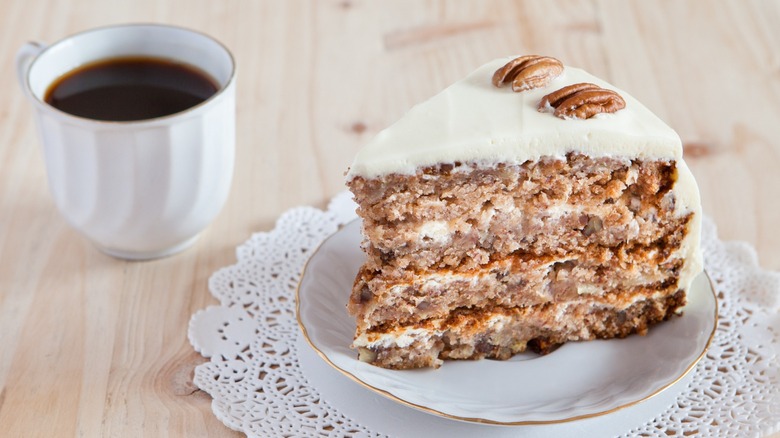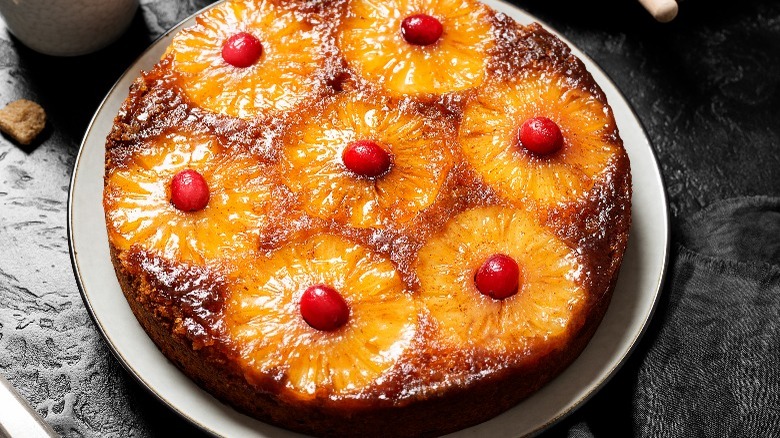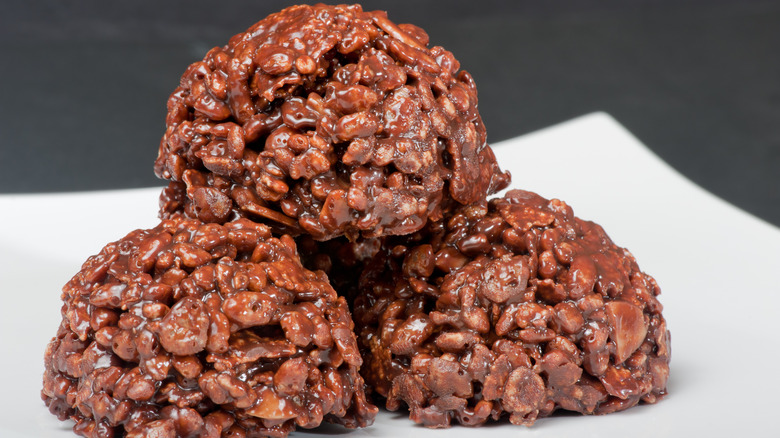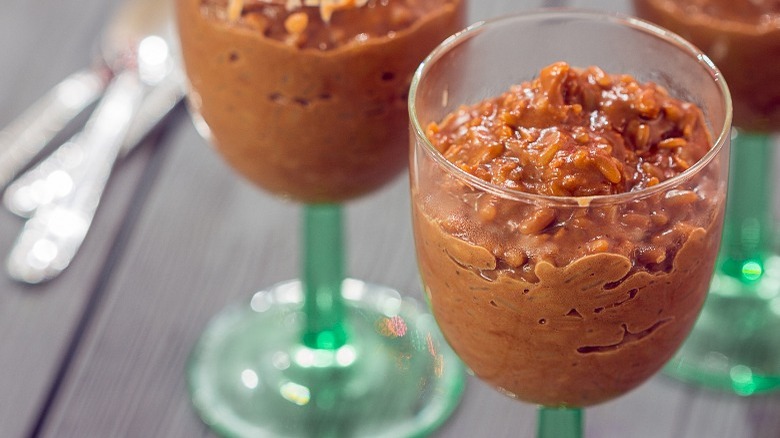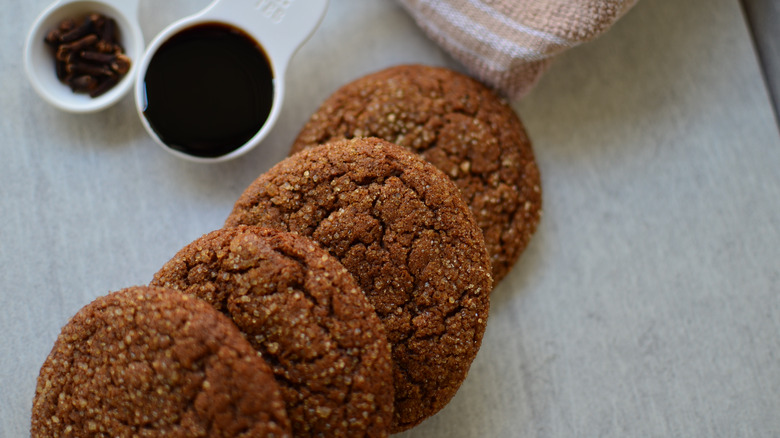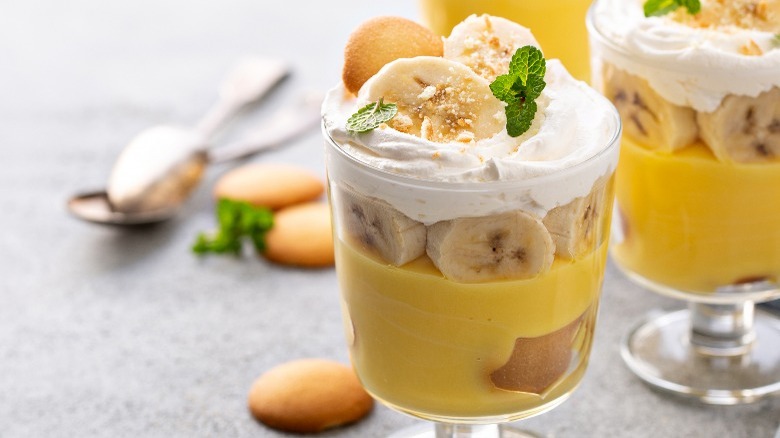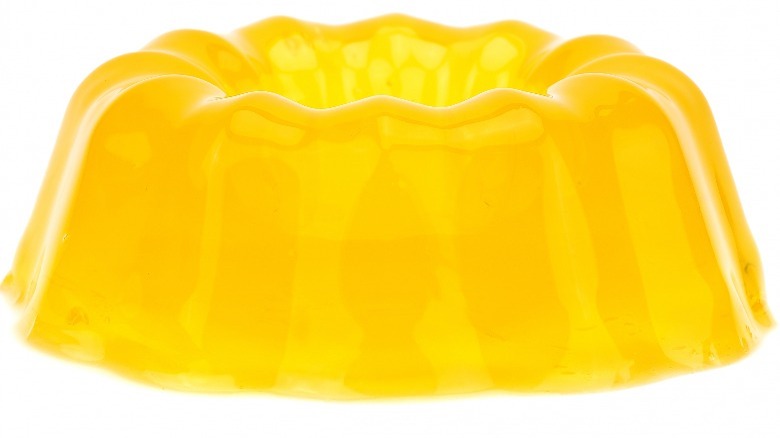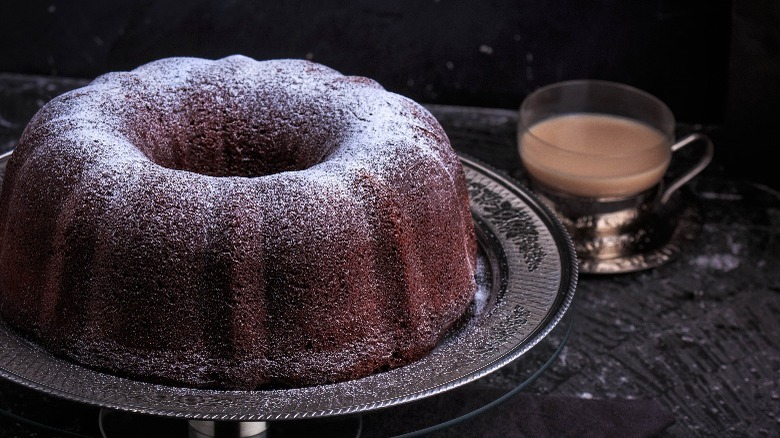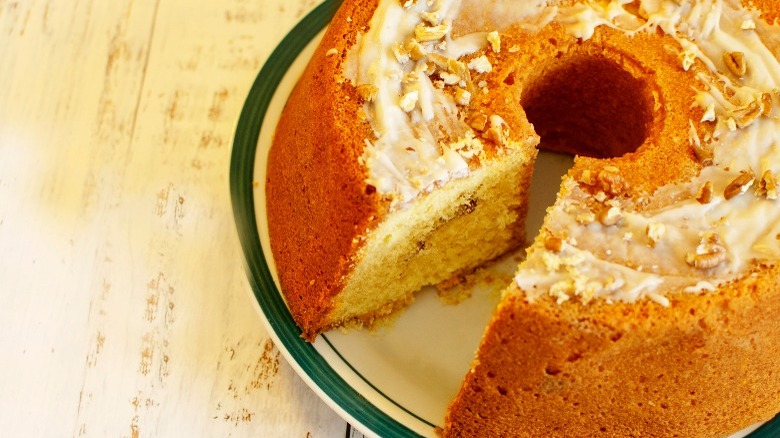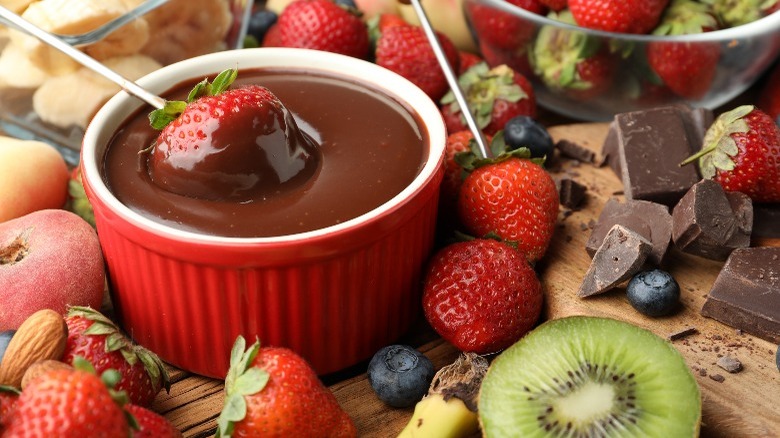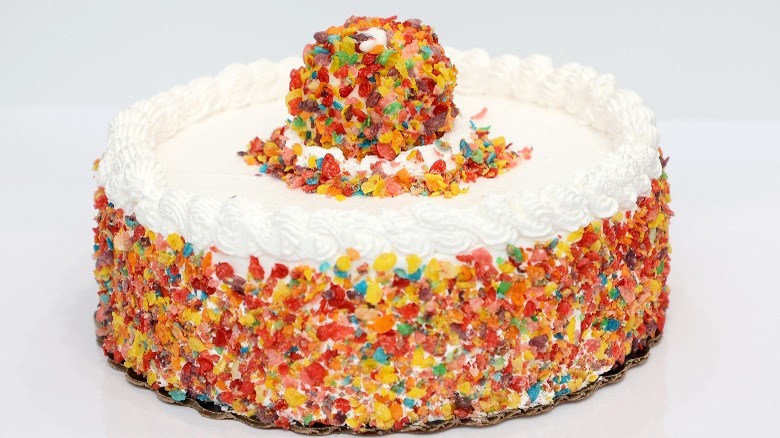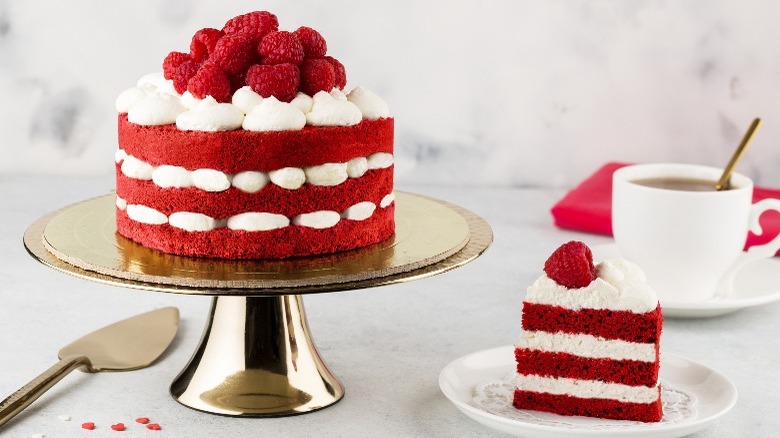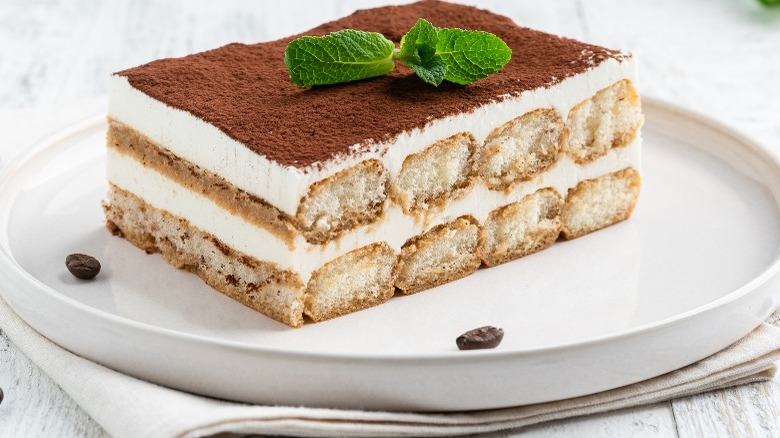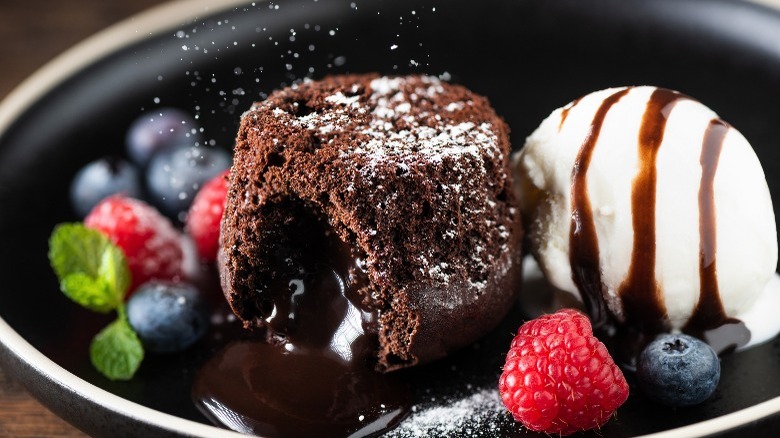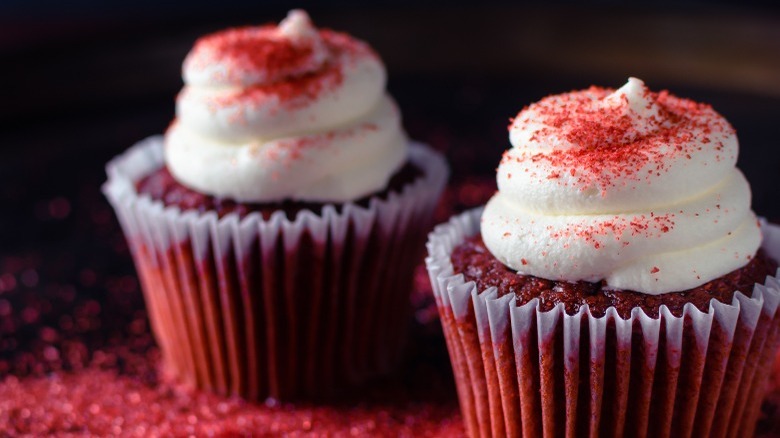The Most Popular Dessert The Year You Were Born
Anyone with a persistent sweet tooth might think dessert is the best part of a meal, and the anticipation is all part of the fun. But just like other food, desserts go in and out of style — and that doesn't mean they don't still taste good. Have you ever heard of hummingbird cake? It looks like carrot cake but is made with bananas. It was a big deal back in the 1960s. It might seem old-fashioned now but don't knock it until you try it.
It's interesting to look at past decades to see which desserts were trending when, and all the reasons behind it. Although the taste was a main factor, sweet endings became popular when famous chefs created them. Other recipes found their way into public consciousness through word-of-mouth, cookbooks, and marketing schemes, and many desserts change over the years. The ones below have unique appeal and reflect points in American history and culture. And while some can't be found at restaurants anymore, they are worth making at home. Keep reading to see which one was being forked up, spooned up, or picked up the year you were born.
1920-1925: Pineapple upside-down cake
These cakes are made with canned pineapples, a fruit first processed this way in the 1860s. It wasn't exciting to eat them straight from the can, but a wise person thought to include them in a cake, and folks in the early 1920s loved it.
The prettiest pineapple upside-down cakes used ring slices instead of chunks. These get mixed and heated with butter and brown sugar before the batter is added; maraschino cherries and nuts can be added for color and texture. After the cake is fully baked, it gets removed from the pan while slightly warm and flipped over to reveal the pineapples. It's an easy trick with a big payoff.
1926-1929: Rice Krispies date pudding
Rice Krispies Treats are one of the simplest dessert snacks you can make. But in the mid-to late-1920s, the cereal was also used in other recipes. Rice Krispies date pudding is a vintage recipe — and you have to crush up the cereal to make it. That gets combined with milk, eggs, chopped nuts, dates, and sugar. The pan must be well greased because once the ingredients heat up, they start getting good and sticky. It takes about 40 minutes to bake at a medium temperature and is best served warm, topped with ice cream or whipped cream. And don't worry about cutting it into perfect squares — feel free to spoon it into bowls.
1930-1935: Potato donuts
The Great Depression lasted from 1929 until 1939, and countless people were living in poverty and made do with less expensive, accessible foods like rice, beans, and potatoes (ever heard of waste not, want not?). People stretched out what was on hand and were creative, with some folks fortunate enough to have desserts for their families.
From this difficult lifestyle arose flourless potato donuts, with a batter made from mashed potatoes, sugar, and buttermilk. Those with access to more sugar, butter, and cocoa topped the cooled donuts with chocolate glaze. These don't taste like potatoes, but you will notice a difference from other donuts. They're light and fluffy and made like regular donuts, and you don't have to deal with all that flour residue. They get fried in oil in an electric or cast-iron skillet.
1936-1939: Chocolate rice whip
Rice pudding was another popular Depression-era dessert and is still popular now because it can be made with leftover rice. In the 1930s, a favorite version was chocolate rice whip. This cool and creamy dessert doesn't need to be oven-cooked and is made on a stovetop. A small amount of unsweetened chocolate gets heated up with cooked rice and a few other ingredients. After it's chilled, you thicken it with whipped cream and stiffly beaten egg whites. Traditional rice puddings use white rice, but this dessert can be played around with. Using rice as the base, try adding raisins, cinnamon, and dark brown sugar instead of basic white. But for the creamiest textures, always stick with whole milk — you only need a cup.
1940-1945: Molasses cookies
These cookies were dessert stars in the 1940s. Since molasses is so sweet, some claim it was because of World War II sugar rationing. One recipe for these cookies was printed in a pamphlet produced by a flavoring extract manufacturer, called the Joseph Burnett Company, during this era, and it called for a cup of molasses and a cup of brown sugar.
It's also been reported that a lot of molasses cookies were sent to World War II soldiers who likely appreciated the effort put in and the sweet, dense taste of these treats. There was also food rationing during World War I, and when no sugar was available, people made molasses cookies without sugar and a few teaspoons of bacon fat.
1946-1949: Banana pudding with vanilla wafers
Kids and adults went for this creamy, crunchy dessert during and after World War II for two reasons. First, My-T-Fine introduced instant pudding so the dessert didn't need to be cooked anymore. Second, Nabisco printed the recipe on its vanilla wafers packages. You'll see these cookies today, but they were rebranded in the 1960s and are now called Nilla Wafers.
Banana pudding with vanilla wafers is a pared-down version of an English trifle recipe made with ladyfingers or cut-up poundcake. Instead of layering homemade custard and a ton of other ingredients, this was simplified with just cut-up bananas, instant pudding, whipped cream, milk, and wafers. Today, it's even easier with non-dairy whipped topping like Cool Whip. And it doesn't even need to be baked; layer it in a trifle bowl or other deep, clear container.
1950-1955: Boston cream pie
Boston Cream Pie was reportedly served for the first time in 1856 at the city's Omni Parker House Hotel, but it enjoyed renewed popularity 100 years later. The original version was made from sponge cake layers and cream, but the real attraction was (and still is) the frosting, which was first made with hardened chocolate fondant. The three different textures are key to this pie that is technically a cake.
So why is Boston cream pie misnamed? When Omni Parker created this dessert, it was likely made in a pie tin since cake pans weren't as widely used. And since that cream layer is often substituted with thick custard, this delicious dessert fits into a category all its own. Thank you, Omni Parker House Hotel.
1956-1959: Lemon chiffon pie
This pie's name perfectly describes what it is — fluffy, light, and, of course, lemony. Chiffon pies were all the rage in the 1950s and were easier to make than baked ones. It was very common to see these and pumpkin chiffon pies in diners and on dinner tables back then.
Lemon chiffon differs from lemon meringue as the latter has custard topped with stiffly-beaten egg whites. A chiffon filling can be made with fresh lemon juice, sugar, eggs, butter, plus gelatin for thickening. After these are combined, heated, and cooled, stiff egg whites are folded in. This filling is considered lemon curd and it gets poured into a prepared pie shell and chilled. The consistency is similar to Key lime pie, but it's not as sweet because it doesn't have sweetened condensed milk.
1960-1965: Jell-O molds
Gelatin was invented in the late-19th century when inventor Dennis Papin boiled down animal bones and congealed the remaining liquid. The first packaged form appeared in 1899 and was later marketed with the slogan "America's most favorite Dessert."
Jell-O molds achieved peak popularity in the first half of the 1960s, helped along by six gelatin recipes in famous cookbooks of the day. These recipes used newer, processed ingredients like Dream Whip that made cooking and baking easier and pointed to the future. Jell-O mold desserts look extra-special in bundt cake molds and you can add in canned, drained fruit salad, Cool Whip, orange juice, and savory additions like cranberries.
1966-1969: Tunnel of Fudge cake
The name of this dessert alone piques the interest of chocolate lovers, and this is a dessert that needs to come back into vogue. It was perfect for the 1960s, the era of convenient, easy-to-make, inexpensive desserts that were heavy on sugar and creaminess.
The dense cake gained notoriety when Ella Rita Helfrich of Houston won second place for its recipe in the prestigious Pillsbury Bake-Off contest of 1966. It was a Pillsbury chocolate cake mix with canned Pillsbury chocolate frosting mixed into the batter and baked in a bundt pan. With so much sugar, the cake didn't harden in the middle and created a decadent, gooey surprise. Some of today's Tunnel of Fudge recipes swap out the canned frosting for extra butter, cocoa, and powdered sugar and get the same results. And feel free to sprinkle it with powdered sugar or cover it in a chocolate glaze.
1970-1975: Sock it To Me Cake
The phrase "sock it to me" came into circulation through several routes. Aretha Franklin sang about it in "Respect" and it was said on the Laugh-in T.V. show that aired from 1968 to 1973. It soon became a marketing tool snapped up by Duncan Hines — the company put together a recipe with its products and named it accordingly.
This yummy bundt cake uses a boxed yellow mix, pecans, and cinnamon sugar. The original recipe added sour cream for moistness and topped the batter with a streusel made from the nuts. And once it was baked and cooled, a thick layer of canned Duncan Hines vanilla frosting was the crowning finish.
1976-1979: Chocolate fondue
The word fondue is French and translates into "to melt," but its history can be traced back to Switzerland, where people learned that bread dipped into melted cheese was scrumptious. Cheese fondue didn't arrive in America until it was introduced at the 1964 New York World's Fair and, around the same time, a Swiss restaurant owner created chocolate fondue during a partnership with Toblerone chocolate.
Americans loved this groovy new dessert, which was more of an event than eating a piece of pie or cake. They gathered around fondue pots and instead of dipping in bread, skewered fruit and squares of pound cake were used. You won't see too many people making chocolate fondue at home anymore, but Melting Pot does it and other restaurants out there still serve fondue, too. And, of course, everyone loves a chocolate fountain at a wedding or Bar Mitzvah.
1980-1985: Ice cream cake
It's not that hard to put together an ice cream cake at home, but doing so can be messy if things start melting too soon. Ordering them is a lot easier, but this dessert had its heyday in the early 1980s. It was very common to head out to Friendly's, Carvel, or Baskin Robbins to pick one up for a birthday or other celebration, and these products were constantly advertised on T.V. Many people who were around in this decade have fond memories of Carvel's Cookie Puss, and here's good news: This place still has Fudgie the Whale. But with ice cream cakes, you must remember two golden rules: Let it thaw for 10 to 20 minutes before serving, and eat it before it melts.
1986-1989: Red velvet cake
The bright color of this cake might turn some people off, but in the late 1980s, it was served often at homes, parties, and restaurants. The redness comes from food dye, and this is what got it noticed. As the legend goes, red velvet cake recipes used buttermilk for moistness, and a version was available at New York's Waldorf-Astoria Hotel. An extract company executive tried it and talked those in charge into using his company's red food dye to enhance the cake's color.
This serves as a nice contrast to the white frosting, which features cream cheese. Things took off for this unique cake in 1989, when it was featured in the Steel Magnolias movie. A new round of fans was born, and you can make red velvet cake nowadays from scratch or a mix.
1990-1995: Tiramisu
As a more sophisticated, Italian version of banana pudding with vanilla wafers, tiramisu was seen on countless restaurant menus in the late '80s and early '90s. The basic version isn't as fancy as it sounds, as it's just made with coffee- or liquor-soaked sponge cake, mascarpone cheese, chocolate, and a sprinkle of espresso powder on the top. The cake can be swapped out with ladyfingers, and you can also add heavy cream.
Tiramisu recipes came into the limelight in 1985 when The New York Times food columnist Marian Burros penned an article about it. And, after a few years, anyone who was anyone was eating tiramisu. Watch that espresso powder, though, because if you're sensitive to caffeine, you might be up all night after eating this creamy dessert.
1996-1999: Chocolate lava cake
Molten chocolate lava cake burst onto the scene in the 1990s after being created in the 1980s by two different chefs. One was French chef Michel Bras, and the second was Jean-Georges Vongerichten, a chef at New York City's Drake Hotel. Bras placed frozen chocolate ganache into dessert ramekins and filled them with chocolate cake batter, but Vongerichten discovered the melty effect after underbaking cupcakes.
In the 1990s, individual chocolate lava cakes were on countless restaurant dessert menus and people craved the runny chocolate centers, warm cake, and toppings of ice cream and whipped cream. The market became oversaturated, and after a time, people had enough, so these cakes were phased out for the most part. But if you are in the mood for one, you can make a quick chocolate lava cake in a mug in just 15 minutes.
2000-2005: Tres leches cake
Tres leches, or three-milk cake, hails from Mexico and can be made with a pound cake or sponge cake base. The three kinds of milk in question can be regular milk, cream, evaporated milk, or condensed milk, but these aren't added to the batter. That is made from flour, eggs, and sugar.
Once the cake is baked, it is allowed to cool slightly, and then, holes get poked into the surface. The milk gets combined and poured on top, and once that's done, you frost it with vanilla icing or add dollops of whipped cream. So why was it so popular in the early 21st century? There was an article about it in the Austin Chronicle newspaper and, after that, Blue Bell and Häagen-Dazs created tres leches ice cream flavors.
2006-2009: Crème brûlée
It's no wonder why crème brûlée was such a big thing from 2006 to 2009. The words have all of those impressive-looking accents and the pronunciation just rolls off the tongue, "Ah yes, I'll have the "crem broo-lay, please." And not only that, but many fine restaurants would heat the sugar on top with a small torch right at your table. How cool is that?
This is a simple dessert at its core, with rich vanilla custard topped with a caramelized sugar shell. But there's nothing like that first moment when your spoon breaks through the outside, and the combination of textures and temperatures is mesmerizing. You won't see it on menus as often nowadays, but look for ice creams, cupcakes, and other treats that are named after it.
2010-2014: Cupcakes
Cupcakes were in big business during the first half of this decade, with everyone and their brother looking to cash in on new ways to bake, market, and sell them. Instead of only being sold at bakeries and food stores, expensive cupcake boutiques were opening to offer them everywhere. And there were many more sizes offered, from mini to jumbo ones that were as big as a slice of cake.
The renewed popularity and subsequent cupcake market oversaturation may have begun when places like New York City's Magnolia Bakery were featured on the show "Sex and the City." Fortunately, there are still bakeries that only do cupcakes but, for now, the hype and competition have calmed down.
2015-2019: Dessert mash-ups
The word hybrid doesn't only apply to cars, trucks, and SUVs, because a short while back, everyone was totally into hybrid desserts. One example of this kind of mash-up would be a dessert lasagna, with Oreos, cream cheese, chocolate yogurt, and whipped cream. Or what about carrot cake cinnamon rolls, or red velvet cheesecake cookie bars?
The love for these combinations hasn't died yet. And, let's face it, even though dessert trends come and go, a good dose of sugar, flavoring, and creaminess will always be the makings of great desserts. And with newer plant-based, gluten-free, and interesting ingredients like Japanese yuzu fruit and purple Filipino ube yams, things can only get better — the 2020s are off to an amazing start.
